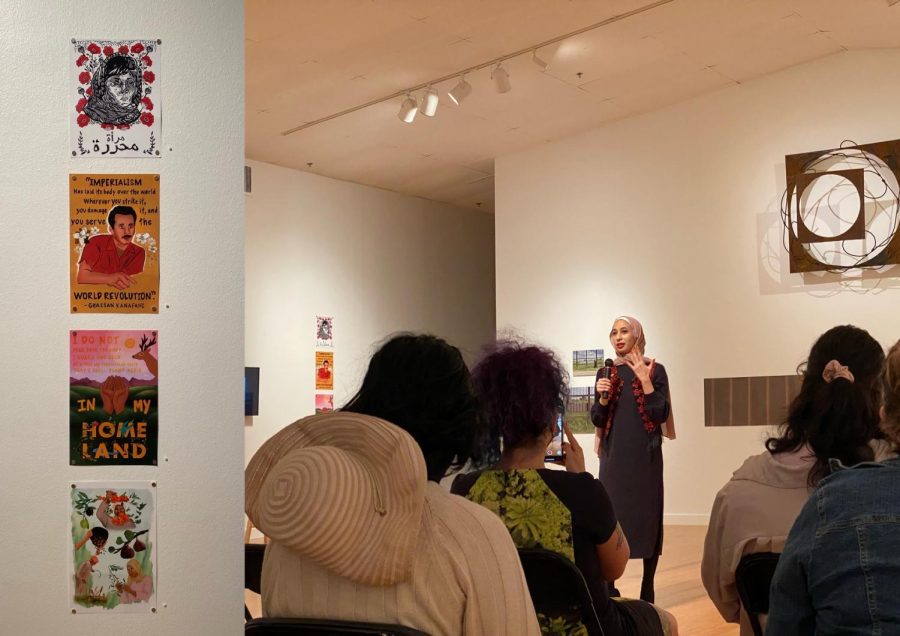Palestine Resistance Through Art
From Oct. 8th to Oct. 17th, Houston’s Station Museum of Contemporary Art presented In The Sun – an art symposium and group exhibition dedicated to exploring the universal connection to the Palestinian struggle. Undoubtedly inspired by the Gilboa prison escape and recent uproar for Palestine, Houston artists and activists formed a coalition that aimed to acknowledge the intertwined nature of oppression.
“Our goals for In The Sun was to encourage dialogue surrounding Palestine as well as the way activist art functions in the museum space. It was born from artists wanting to discuss human rights violations (part of the museum’s mission statement) in Palestine,” Associate Director of the Station Museum Sophie Asakura said.
In support of Collective Artists In Solidarity with Palestine (CASP) and the Palestinian Youth Movement (PYM), In The Sun was arranged in order to depict the themes of interconnected struggle, systemic oppression, and social injustice of different cultures and forms as a means of empathizing with the Palestinian people.
“We are going to be looking at that topic [opression], specifically from the lens of cultural production, its various forms, and the role that it plays in movement, struggling against it, and living through it,” said a leading member of the PYM Muhammad Nabulsi.
Within the exhibition, artists and activists alike used their personal and ethnic histories as a means of attracting awareness to undermined and universal struggles. For example, Angel Lartigue, a leading artist of CASP, utilized her Mexican background in order to draw parallels from what would appear to be ‘different’ issues.
“Most of my work focuses on the South Texas borderland – the United States-Mexico border – and using material from that area to express the strive for liberation,” said Lartigue.
While In The Sun demonstrated great diversity among artists and activists, the exhibition still managed to amplify the voice of the Palestinian directly, as illustrated by Palestinian-American artist Lina Habazi. Habazi proudly displayed her art depicting her homeland’s history, traditions, ongoing struggles, as well as emphasizing her own Palestinian identity.
By bringing attention to other issues of the same boat and highlighting Palestine’s empirical struggle, In The Sun not only managed to effectively spark a sense of recognition and empathy toward the other side but also demonstrated Houston’s incredibly strong community of self-expression and activism.
Oppression isn’t specific to any one singular region nor does it comply with general politics; it is a concept of which is shared among various parts of the world that fight against injustice.
Despite In The Sun’s remarkable success in gaining public attention regarding the Palestinian struggle, October saw yet another emergence of resistance through art. On Oct. 10th, the global streaming service, Netflix, announced that they will launch a collection of 32 Palestinian films on Oct. 14th. Among these films include Annemarie Jacir’s Salt of This Sea (2008), Elia Suleiman’s Divine Intervention (2002), and Mahdi Fleifel’s A Drowning Man (2017), all of which examine contemporary life in Israeli-occupied Palestine.
Although Palestine has been faced with utmost social, economic, and agricultural instability for almost a century, its spirit will continue to thrive through passionate contemporary artists and activists who will not stop expressing themselves until justice is bestowed upon the Palestinian people and the marginalized groups of the world.




Sarah • Nov 11, 2021 at 3:37 pm
This is awesome! Thank you for sharing.
Jamal Saadah • Nov 2, 2021 at 5:40 pm
A very succinct and articulate presentation of the continued Palestinian struggle. Thank you for sharing your thoughts with us Yezen Saadah!
Lamar Life • Nov 2, 2021 at 5:46 pm
Thank you for reading Lamar Life! We appreciate the feedback and support!